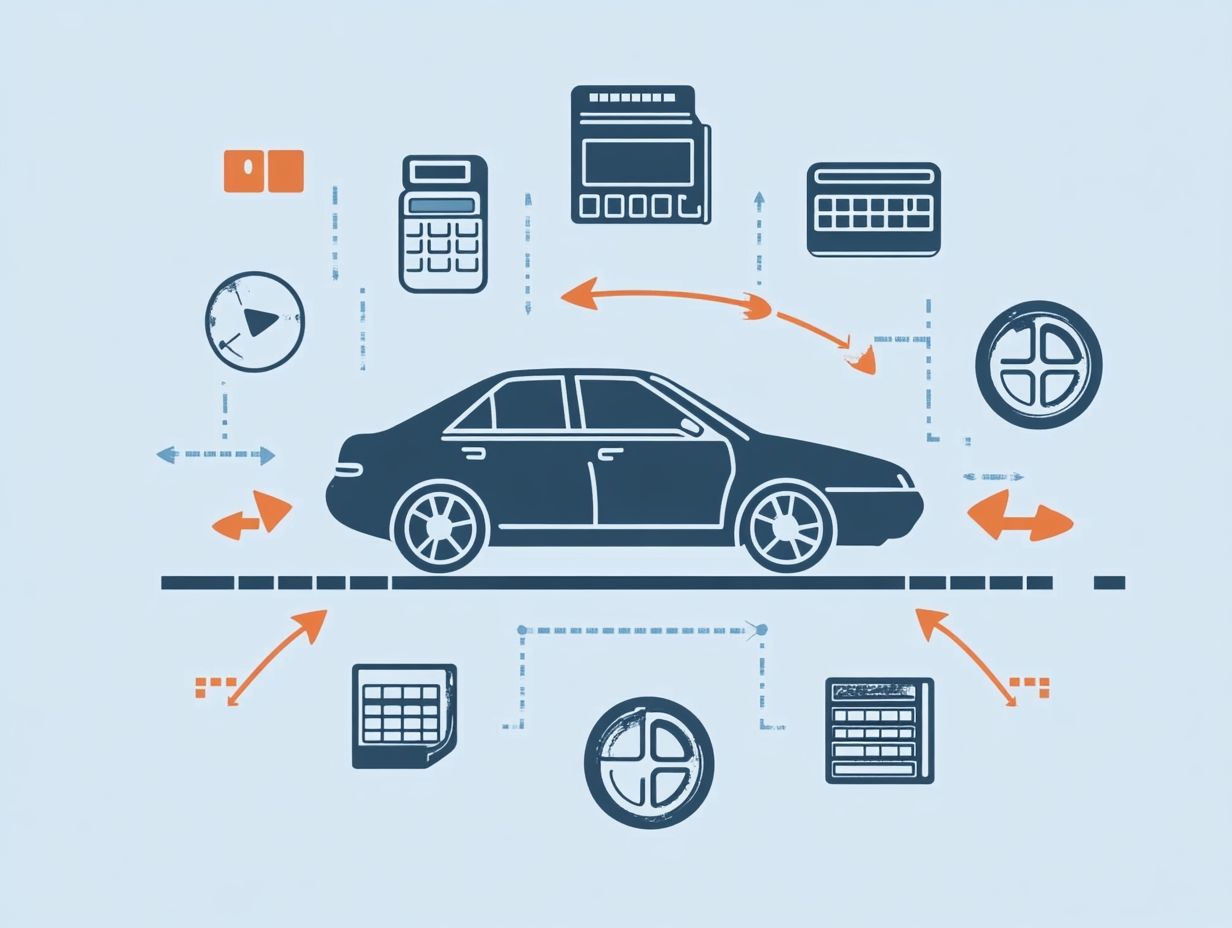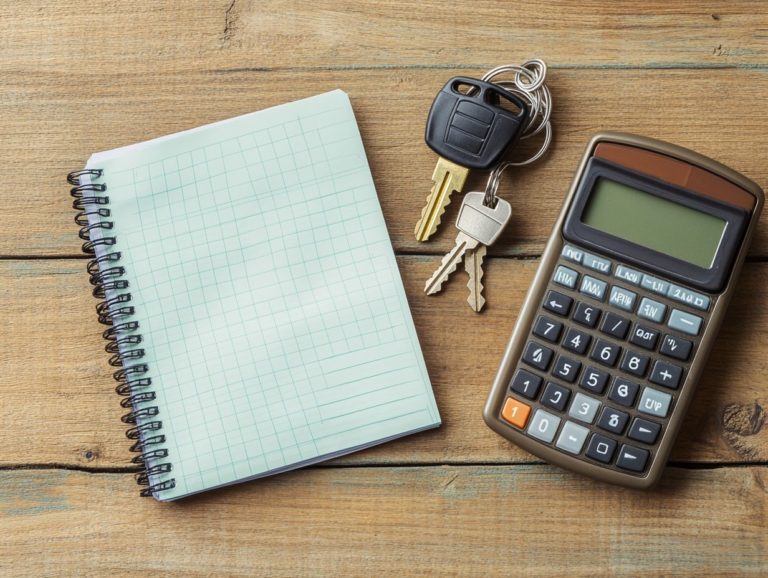A Guide to Understanding Residual Value in Leasing
Understanding residual value is essential for anyone contemplating a vehicle lease. It directly impacts your monthly payments and shapes the overall terms of your lease.
Several factors contribute to this value, including the make and model of the vehicle, its condition, and the mileage it accumulates.
This article delves into calculating residual value, offers strategies to maximize it, and provides tips for negotiating a better deal.
Engage with the content to elevate your leasing knowledge and empower yourself to make informed decisions!
Contents
- Key Takeaways:
- Why Residual Value Matters in Leasing
- Factors that Affect Residual Value
- Calculating Residual Value
- Strategies for Maximizing Residual Value
- Frequently Asked Questions
- What is residual value in leasing?
- How is residual value determined?
- Why is residual value important in leasing?
- Can the residual value be negotiated?
- What happens if the actual market value of the vehicle is lower than the residual value?
- Is it better to have a higher or lower residual value in a lease?
Key Takeaways:

- Residual value is the estimated worth of a leased vehicle at the end of the lease term and plays a significant role in determining monthly payments and lease terms.
- Factors such as the make and model of the vehicle, its condition, and mileage can affect the residual value and should be considered when choosing a car to lease.
- To maximize residual value, negotiate a higher value at the start of the lease and maintain the vehicle’s condition by following the manufacturer’s maintenance recommendations and avoiding excessive wear and tear.
What is Residual Value?
Residual value is an essential concept in car leasing. It represents the estimated worth of your vehicle at the end of the lease term. This value depends on various factors, including the vehicle’s Manufacturer’s Suggested Retail Price (MSRP), depreciation rate, and anticipated market conditions such as consumer preferences and economic trends.
By grasping residual value, you empower yourself to make informed decisions when entering a lease agreement with a dealership or leasing company, as it directly impacts your monthly payments and end-of-lease options.
Calculating residual value involves evaluating the vehicle s projected depreciation, often expressed as a percentage of its original price. Elements like brand reputation, demand in the used car market, and typical annual mileage can significantly influence this figure.
For instance, vehicles known for their strong resale value generally boast higher residual values, which means lower monthly payments for you. Conversely, vehicles that tend to depreciate quickly could lead to heftier payments.
Knowing how leasing companies set this value is key to getting the best deals for anyone looking to secure the most favorable leasing options.
Why Residual Value Matters in Leasing
Residual value plays a crucial role in leasing. It significantly impacts the total cost of leasing a vehicle, shaping both your monthly payments and overall lease terms.
A higher residual value can lead to lower monthly payments, making those luxury brands or economical options more within reach.
As you approach the end of your lease, knowing the residual value helps you assess your options effectively, whether it s considering a lease buyout or negotiating the buyout amount with your leasing company. With this knowledge, you ll be empowered to make savvy decisions, maximizing the benefits of your leasing experience.
Impact on Monthly Payments
The impact of residual value on your monthly payments is significant. A higher residual value often translates to lower payments throughout the lease term. This happens because your monthly payments are calculated based on the difference between the vehicle’s MSRP and its residual value at the lease’s end, divided over the lease duration.
Therefore, grasping the depreciation rate and its effect on residual value is crucial if you re seeking favorable leasing options and more manageable monthly payments.
Consider this: if you compare two similar vehicles with different estimated residual values let’s say 50% and 40% after three years you ll notice a marked difference in the monthly payments. In the first scenario, where the residual value is higher, you might enjoy lower monthly payments, which enhances your cash flow and could even open the door to more desirable vehicle options.
Market conditions, including supply and demand, also play a role in influencing these residual values and, by extension, your lease agreements. It s vital for you to scrutinize these factors closely to optimize your leasing experience and minimize overall costs effectively.
Influence on Lease Terms
Residual value plays a crucial role in shaping lease terms, influencing aspects like mileage allowance, maintenance requirements, and overall contract flexibility. When a leasing company evaluates the projected residual value, they establish conditions that reflect anticipated vehicle depreciation and market trends. This ensures you can select terms that align with your driving habits and financial objectives.
By grasping how residual value impacts lease agreements, you ll be empowered to negotiate deals that suit you perfectly.
For example, if the expected residual value is high, the leasing company may offer a more generous mileage allowance perfect for those who are always on the go. A lower residual value could lead to stricter mileage limits and heightened maintenance requirements to help manage potential wear and tear.
By familiarizing yourself with these dynamics, you can approach leasing negotiations with confidence. This knowledge can potentially influence more favorable mileage limits and secure comprehensive maintenance packages that not only suit your driving style but also contribute to long-term cost savings.
Factors that Affect Residual Value

Several factors play a crucial role in determining residual value, making it essential for you to understand the impact of depreciation on leasing when leasing a vehicle.
The make and model of the car are particularly significant. Certain luxury brands tend to retain their value more effectively than economy vehicles.
Additionally, the condition of the vehicle at the lease’s conclusion, including mileage and maintenance records, is essential.
Market conditions and broader economic factors greatly influence how well a vehicle holds its value, ultimately impacting both the depreciation rate and the calculation of residual value.
Make and Model of Vehicle
The make and model of a vehicle play a pivotal role in determining its residual value. Luxury brands consistently outshine economy cars in value retention. When you choose a vehicle from a reputable manufacturer, you’re tapping into a strong market presence and demand, which translates to higher residual values at the end of the lease term.
Understanding the nuances between different makes and models gives you the power to select a vehicle that not only aligns with your personal preferences but also offers advantageous leasing options and potential savings over time.
Take brands like BMW and Lexus, for example. Their reputations for durability and desirability often result in less dramatic depreciation compared to more budget-friendly options like compact sedans.
While an economy car may shed a significant portion of its initial value within just a few years, luxury models tend to hold their worth better, thanks to factors such as brand loyalty and enhanced features.
This variance in depreciation rates doesn’t just affect resale value; it also influences financing options. So, it’s essential for you to consider these factors carefully when contemplating your next vehicle purchase.
Vehicle Condition and Mileage
The condition of your vehicle and its mileage are crucial when assessing its residual value, as both significantly affect depreciation rates. A well-maintained vehicle with lower mileage typically retains a higher residual value compared to one that shows signs of wear or exceeds its mileage allowance.
This means you should prioritize keeping your vehicle in top shape throughout the lease term. It impacts the residual value and influences your potential end-of-lease options, like a lease buyout.
Regular maintenance think oil changes, tire rotations, and inspections is essential for preserving both the health and aesthetics of your vehicle. By staying on top of these routine services, you can help mitigate the factors that contribute to depreciation.
Moreover, avoiding accidents and maintaining the interior and exterior can make a significant difference when it s time to return the lease. If you hand back a vehicle in excellent condition, you’re likely to face fewer fees and have better negotiation power regarding purchase options.
This ultimately leads to a smoother transition at the end of your lease term.
Calculating Residual Value
Calculating residual value is crucial for you to grasp the complete costs tied to leasing a vehicle. There are several methods available for this calculation.
Leasing companies frequently rely on depreciation rates and historical data to estimate a vehicle’s worth at the end of the lease term. This helps them set more accurate pricing in lease agreements.
By familiarizing yourself with the different methods of residual value calculation, you can empower yourself to negotiate better leasing options and effectively manage your monthly payments.
Methods and Formulas
Several methods and formulas are at your disposal for calculating residual value, each considering the vehicle’s initial MSRP, estimated depreciation rate, and current market conditions.
One widely-used approach is the straight-line depreciation method. This method distributes the vehicle’s depreciation evenly across the lease term. Alternatively, you might encounter accelerated depreciation methods that factor in projected wear and tear.
Understanding these calculations empowers you to anticipate the residual value and make well-informed choices when entering a lease agreement.
For example, if you utilize the straight-line method for a vehicle with an MSRP of $30,000 and a lease term of three years, resulting in total depreciation of $15,000, the annual depreciation would amount to $5,000. This means the expected residual value at the end of the lease is $15,000.
On the other hand, if you opt for the double-declining balance method, which is a method that calculates depreciation at a faster rate in the early years, you may experience steeper depreciation during the initial years. With a depreciation rate of 20%, your first-year depreciation would jump to $6,000, leading to a more rapid decline in value.
Learning these methods helps you evaluate leasing costs effectively and understand the critical role accurate calculations play in negotiating favorable terms.
Strategies for Maximizing Residual Value

Want to get the most out of your car lease? Maximizing residual value is key! Maximizing residual value should be your top priority when engaging in car leasing, as it directly influences your lease agreements and end-of-lease options.
By implementing effective strategies like maintaining your vehicle s condition, adhering to mileage allowances, and opting for high-demand makes and models you can significantly boost your vehicle s residual value.
Mastering these strategies not only helps you secure favorable monthly payments, but also positions you for advantageous buyout amounts when your lease comes to an end.
Tips for Negotiating a Higher Residual Value
Negotiating a higher residual value can lead to significant savings, so don t miss out! It can also reduce your monthly payments and overall lease costs, giving you a distinct advantage when entering leasing agreements.
To achieve this, it’s crucial to conduct thorough market research to understand the typical residual values for specific makes and models.
Armed with this knowledge, you can leverage it during discussions with your leasing company. Showcasing a strong credit history and seeking competitive quotes can further enhance your bargaining power.
It s essential to compare values across various leasing companies, as this can reveal discrepancies that may work in your favor.
Engaging with knowledgeable industry experts or utilizing online tools for estimating future vehicle values can also be invaluable.
Be prepared to negotiate not just the residuals, but also other terms like mileage limits and maintenance inclusions; these factors can significantly influence the overall cost of your lease.
By presenting a well-researched and confident approach, you can greatly improve your chances of securing favorable lease terms that align with your financial goals.
How to Maintain Residual Value
Maintaining the residual value of your leased vehicle requires active care to preserve both its condition and mileage within the permitted limits.
Committing to a regular wash and wax schedule enhances the aesthetic appeal of your vehicle and protects the paint and underlying surfaces from wear and tear. Addressing minor issues, such as scratches or dents, promptly can prevent them from escalating into costly repairs. Get to know your lease agreement s mileage caps to avoid hefty penalties.
By prioritizing careful vehicle maintenance and smart mileage management, you can boost your overall lease experience, paving the way for more favorable terms when it’s time to transition into a new vehicle. Start maintaining your vehicle today to boost its value!
Frequently Asked Questions
What is residual value in leasing?
Residual value is the estimated worth of your car at the end of the lease term. It is an important factor in determining the monthly lease payments and overall cost of a lease.
How is residual value determined?

Residual value is determined by the projected depreciation of the vehicle over the lease term, based on factors such as the vehicle’s make and model, market demand, and anticipated mileage.
Why is residual value important in leasing?
Residual value plays a crucial role in determining the overall cost of a lease. A higher residual value means a lower monthly payment, while a lower residual value means a higher monthly payment. It also affects the buyout price at the end of the lease.
Can the residual value be negotiated?
In most cases, the residual value is non-negotiable as it is set by the leasing company. However, if you have a high credit score or are a returning customer, you may have some leverage in negotiating a lower residual value.
What happens if the actual market value of the vehicle is lower than the residual value?
In this scenario, you may owe the leasing company the difference between the residual value and the actual market value. This is known as a lease-end deficiency and can be avoided by accurately estimating your annual mileage and taking good care of the vehicle.
Is it better to have a higher or lower residual value in a lease?
It depends on your personal preferences and financial situation. A higher residual value means lower monthly payments and potentially lower overall cost, but you will have less equity in the vehicle at the end of the lease. A lower residual value may result in higher monthly payments, but you will have more equity in the vehicle if you decide to purchase it at the end of the lease.
Have more questions? We’re here to help!






